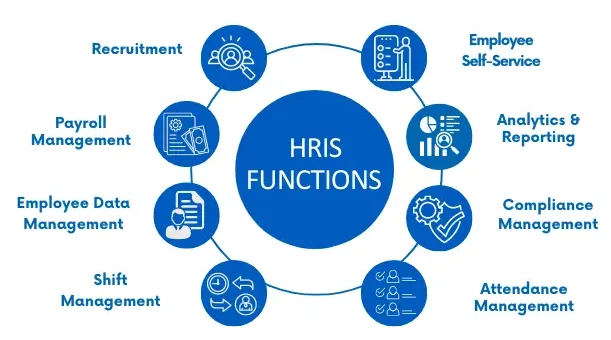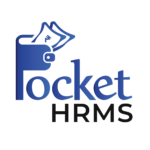
What is HRIS (Human Resource Information System)?
Table of Contents

Reading Time: 11 minutes
A dedicated Human Resources Information System or HRIS is used in organizations to streamline employee and HR management. It automates several tasks related to the administration of employees in a company, leading to increased engagement. However, how relevant is an HRIS to a company and what are its benefits?
Let us find out.
HRIS Meaning
HRIS stands for Human Resources Information System. It is a software that helps the HR department manage and process employee information to streamline its tasks and simplify employee management. It provides them with an interactive system for the management of employee information by standardizing HR processes and enabling in-depth reporting and analytics.
HRIS vs HRMS vs HCM
While the terms HRIS, HRMS, and HCM are used interchangeably, there are subtle differences between them. Let us check out each of these systems to understand the differences between them:
1. HRIS
Human Resource Information System or HRIS is the most basic of the systems mentioned above since it provides core HR functions along with secure employee data management. It simplifies core HR functions such as recruitment, payroll, data management, benefits administration, compliance, etc.
2. HRMS
Human Resource Management System or HRMS provides all the features of HRIS, while also incorporating additional features such as applicant tracking, performance management, employee engagement, talent management, etc. HRMS also provides enhanced functionalities to act as a single software for the HR department.
3. HCM
Human Capital Management or HCM refers to two different things related to HR personnel: it refers to the set of practices used by HR to manage their employees, or it can also refer to the set of tools and software used by HR to manage their staff effectively. Hence, it covers all aspects of employee management, including HRIS and HRMS.
Types of HRIS
Based on the functionalities provided, HRIS can be classified into various categories. While the over-arching functions of HRIS remain common, the different types of HRIS fulfil various aspects of HR processes and operations.
So, let us check out the different types of HRIS available in the market currently:
➔ Comprehensive
Comprehensive HRIS is a complete HR software that stores and manages all information related to HR management processes. As a result, it provides a central data repository of all employee information which helps the HR in supporting and managing their staff. A comprehensive HRIS is usually deployed by large organizations since they require a complete system that can provide valuable insights into employee data and make it available to other related systems.
➔ Operational
Operational HRIS provides additional tools to improve the functioning of an existing system by managing employee data efficiently. As a result, it enables the HR teams to manage their staff effectively, especially with recruitment, promotions, and other talent management requirements. HRIS functions such as Applicant Tracking System (ATS) or a performance management system come under the category of operational HRIS.
➔ Limited
A limited HRIS has a limited scope in its functions. For example, a smaller company would require a limited-scope HRIS with recruitment and payroll features, while avoiding training and additional benefits administration. Hence, it is usually preferred by smaller organizations as they need limited utilities only, while also saving money on HRIS expenditure.
➔ Tactical
A tactical HRIS provides the HR teams with data that enables them to optimize their operations improving organizational efficiency. It enables them to understand the resource usage within the company and make the necessary changes to utilize them effectively. It aggregates the data from external sources too to help the HR understand their company’s position in the market.
➔ Strategic
Strategic HRIS provides data to the HRs that helps them with decision-making. It enables the HR teams to analyze their workforce, set their annual organizational goals, and more. With the help of strategic HRIS, companies can structure their growth and track advanced metrics which helps them understand their company’s employer brand and market positioning.
HRIS Functions
HRIS provides several functionalities for the HR teams, which enable them to manage their employees and their data seamlessly. These functionalities enable the HR teams to streamline their processes, enabling easier management of employees and their data.
Some of the most important HRIS functions are:

1. Recruitment
Recruitment is one of the most basic functions of HRIS since it enables the HR teams to attract and retain talented candidates. Being a recruitment software, it provides various functionalities related to hiring such as scanning and parsing resumes, developing a candidate pool, etc. to ensure simplified hiring of candidates effectively. Modern HRIS also provides HR with enhanced candidate analytics by letting them know of the ‘suitability’ of the candidate for the vacant position.
2. Payroll Management
Payroll management is another important function of HRIS which enables the HR teams to disburse accurate salaries every salary cycle. The payroll management system calculates employee payroll, while automating compliance handling, as well as automatically tracking late-coming, early leaving, overtime, benefits administration, etc. By automating this process, HRs can provide accurate salaries every salary cycle, ensuring on-time salary disbursals.
3. Employee Data Management
HRIS also enables the HR teams to manage their employee data automatically. It provides secure enterprise-grade databases with advanced encryptions for added security, while also restricting access with ‘access control’ options. As a result, the employee information can be easily organized, while also making it easily accessible to the staff members through their mobile devices.
4. Shift Management
Similarly, shift management is another essential aspect of all HRIS software since it enables the HR teams to allocate shifts easily to their staff members. Additionally, it also works in tandem with the attendance management system to capture attendance accurately. By automating employee shift management, HRIS provides the HR team with a streamlined option to manage employee shifts.
5. Attendance Management
Attendance management is another function of HRIS which enables the HR teams to capture and store employee attendance for accurate records. By using attendance management software, companies can enable modern foolproof attendance capture technologies such as biometric scanning (with fingerprint, retina, facial, etc.), geo-tracking, geofencing, etc.
6. Compliance Management
A dedicated HRIS also automates the process of compliance maintenance by automating the process of removal of statutory deductions from employee salaries and ensuring the disbursal of employee benefits, such as state-sponsored medical insurance, retirement plans, etc. It also helps in keeping the working hours to the stipulated hours, as well as ensuring that the employees’ payments are compliant with the statutory regulations.
7. Analytics & Reporting
HRIS software also provides multiple options for analysing the numerous metrics related to the business. Being a human resource management information system, it provides advanced reporting tools to enable the management and the HR teams to make informed decisions. Modern HRIS can even make calculated guesses based on predictive analytics to help the company stay on course towards success.
8. Employee Self-Service
HRIS provides multiple options for employee self-service such as a dedicated web portal and mobile app. It makes the process of accessing and working with employee data easier for the staff members. Using the self-service portals also frees the HR from having to interfere in the tasks of employees such as applying for leaves, scheduling training, etc. since it can be undertaken by their supervisors through their self-service options.
Objectives of Human Resource Information System
There are multiple objectives of HRIS which support the HR team in streamlining their employee management operations. While the exact objectives of HRIS differ from company to company, the objectives we have shared below are common to almost all HRIS, which enables them to function according to the organizational requirements:
➔ Employee Data Repository
The main objective of an HRIS is to provide the HRs with a secure employee data repository. It enables the HR team to collate, organize, and store employee data in a secure database. It helps the HR teams avoid complicated and error-prone paperwork, making it easier for them to store employee data securely.
➔ Streamlined HR Operations
A robust HRIS also helps streamline HR operations by providing a centralized data repository for all HR requirements. It helps them analyze their data quickly to make informed decisions, leading to better organizational resource allocation, and improving the overall work efficiency. With automated HR operations, the HR team can also allocate their productive hours to other creative pursuits like strategizing employee engagement.
➔ Data-backed Decision-making
Since HRIS provides excellent options for managing employee data effectively, it can be used to make data-backed decisions. Modern HRIS even employs predictive analytics to predict future employee behaviour based on past trends, letting the HRs take corrective measures even before a negative outcome occurs. With such advanced tools at their disposal, HRs can ensure organizational success.
➔ Complete Compliance
Similarly, 100% compliance with the local and national laws is another objective of HRIS software. The software takes care of the compliance part of the storage and retrieval of employee data, freeing HR from having to worry about it. Similarly, all HR operations undertaken with the help of HRIS also follow the statutory laws, helping the company avoid hefty fines for non-compliance.
Importance of Human Resource Information System
HRIS is very important to organizations as it provides:
- A unified and secure employee database.
- Draw meaningful inferences with in-depth analytics.
- Automatically maintain legal compliance.
- Streamlined HR processes and workflows.
- Enhance employee experience with self-service options.
- Improved HR efficiency.
Benefits of HRIS
There are several advantages of deploying an HRIS in an organization. These benefits range from enhanced experiences to data-backed decisions. Some of the most significant advantages are:
➔ Data-backed Decisions
HRIS provides multiple options for HR to generate and download custom reports that enable the decision-making authorities such as managers and senior management to make informed decisions. With such decisions, they can compare the positive changes brought about by their decisions, making HRIS a must-have tool for companies.
➔ Improved Efficiency
Since the information is stored digitally in an HRIS, it becomes effortless to fetch it whenever required. Additionally, it can be accessed easily through mobile-friendly interfaces and even dedicated mobile apps. Such easy access to the database makes HR tasks more streamlined since they can access their employee information quickly.
➔ Security & Integrity
HRIS provides additional security and enhanced integrity to the employee database by storing the information in the format imposed by local regulations. As a result, the data remains secure in the system in an encrypted format. Similarly, personnel with the right credentials only would be able to access the information, thereby maintaining abstraction.
➔ Compliant Records
The employee data in HRIS is stored in an encoded format using best-in-class encryption standards to provide enhanced security and integrity. Since employee information is critical to the company processes, keeping the data according to the regulations is highly imperative, and failure to do so could even result in hefty penalties.
➔ Enhanced Experience
With the help of an HRIS, employees can view and edit their information, making the process highly transparent. Additionally, their HR will approve the changes, ensuring the avoidance of any errors in the database. The user experience will also be enhanced since they can access essential information such as their payslips, remaining leaves, holidays, and more without having to contact the HR department.
➔ Predictive Analytics
Modern HRIS also provides predictive analytics which enables the HR and management to take corrective measures to ensure organizational success. Since the predictions are based on organizational trends and historical data, the management can make changes to their operations to avoid any future disruptions.
➔ Increased Productivity
Since HRIS provides a central data repository for the HR teams, making changes to the employee master data or company-wide changes becomes extremely easy for them. Similarly, through streamlined approval workflows, the employees and managers can avoid contacting HR and directly interact with the system for approvals, while the system notifies them to help them stay abreast of the developments. Hence, it improves overall HR productivity while also making this data available remotely.
Future of HRIS technology
The future of HRIS involves actively using innovative technologies to aid the HR team in undertaking their duties by storing the data and providing insights into employee behaviour. With the rise in globalization and hybrid workforce, an HRIS is becoming indispensable in companies that wish to engage their staff and improve the efficiency of their HR professionals.
Hence, we have compiled a list of a few future usages of HRIS:
1. Artificial Intelligence
We are already witnessing the integration of AI in HRIS to enable various optimizations in employee, and their data management. An AI-based HRIS can also help HR with predictive analysis, wherein the system effectively calculates and predicts the future probability of a negative or positive action, allowing HR to take corrective actions to ensure organizational success.
2. Performance Management
Future-ready HRIS solutions can provide comprehensive 540° employee performance management, making it easier for HR and management to keep track of their employee performance. Such systems will also help deliver year-round reviews instead of annual performance reviews, making the process more effective for improving organizational performance.
3. Machine Learning
With the introduction of Machine Learning in HRIS, HR personnel can streamline multiple tasks related to employee engagement. While HRIS has already improved the overall efficiency of the HR department by digitalizing most of their process, machine learning would further help optimize these processes. For example, it can highlight any outlier in the employee data and alert the HR team to ensure complete data integrity.
Choosing the Best HRIS for Your Business
Choosing a new HRIS platform is extremely daunting since it helps take care of the different critical aspects of human capital management. Not all HRIS systems are the same; hence, you should choose the HRIS after discussing and brainstorming with the heads of various relevant departments.
We are sharing some of the common steps involved in the implementation of HRIS:
➔ Research
Research is the most important step in choosing an HRIS for your company. You should check out various HRIS providers and find the one who can customize their software to suit your business requirements and HR processes. Hence, by the end of this stage, you would have chosen a software vendor.
➔ Planning
Once you choose one of the multiple HRIS platforms available, you should work with their implementation team and HRIS analyst to identify the customizations required by your organization. It would be best if you guide their team in understanding the exact software requirements, including the solutions to the various problems while allocating the budget accordingly.
➔ Design
Once the requirements are ready, you should be prepared to provide in-depth analysis and details about each module for the HRIS processes. You can define the functional and technical needs of the HRIS and note down the integration requirements at this deployment stage.
➔ Configuration
Once the design details are ready, you can configure the HRIS accordingly and test it with a test group. Once the test bench is ready, you can create user acceptance tests and share them with another test team to gather feedback and improvements and make the necessary changes.
➔ Training
Once you have set up the system as per your requirements, you need to train your staff to use it efficiently. Employee training can be undertaken with the help of the implementation team along with a dedicated employee training management system.
➔ Deployment
Once the HRIS is ready, you can deploy the system and observe how well your employees are adapting and adopting the system. You need to constantly collect feedback from your staff and suggest changes to the software vendor for further enhancements, which helps make the software even more user-friendly.
Conclusion
So, that was a complete overview of the Human Resources Information System or HRIS. In this comprehensive guide, we have shared the various functions and the different types of HRIS available in the market. We have also understood the benefits and the importance of HRIS for organizations. Similarly, you can create a checklist for choosing the best HRIS for your company as well as understand the future of HRIS technology.
FAQs on HRIS
1. What is the full form of HRIS?
The full form of HRIS is Human Resources Information System. HRIS software helps the HR department store and manage their employee information effectively.
2. What does HRIS do for an organization?
HRIS helps the HR teams manage their employee data effectively through automated management and streamlined processing of their data. Since it automates the HR processes, HRIS can provide several benefits to the organization, such as:
- Data-backed Decisions
- Improved Efficiency
- Security & Integrity
- Compliant Records
- Enhanced Experience
- Predictive Analytics
- Increased Productivity
3. Can an HRIS help with recruitment?
Absolutely, modern HRIS comes with modules for core HR processes, which include recruitment. Hence, it provides various options to streamline the hiring process, such as job creation, candidate profiling, interview scheduling, candidate tracking, analytics and reporting, and more.
4. What is an example of HRIS working?
An example of HRIS working would be entering employee data while onboarding and using this information for payroll and benefits, time and attendance, etc. Later, this information can be updated whenever required by the employee (with the approval of their manager or HR) or by the employer.
5. Who uses a Human Resource Information System?
HRIS is used by HRs to streamline human capital management systems that provide them with innovative solutions for optimizing their processes’ efficiency and enhancing their employee engagement efforts.
6. What are the advantages and disadvantages of HRIS?
There are multiple advantages of HRIS, such as workflow automation, enhanced integrations, centralized database, among others. However, as automated technologies advance, there are numerous disadvantages for HRIS too, such as data security, overspending, reduced ROI, among others. However, one must understand that almost all of these drawbacks can be overcome with the correct implementation of the system.







